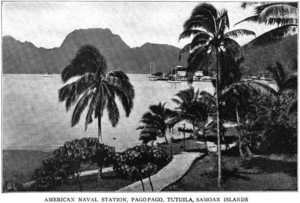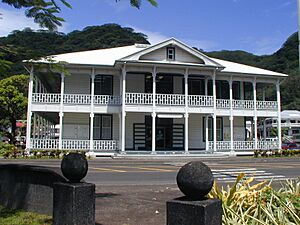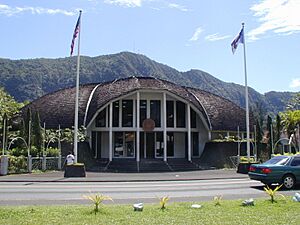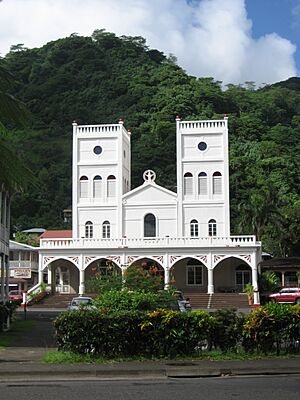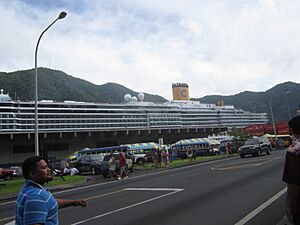Fagatogo, American Samoa facts for kids
Quick facts for kids
Fagatogo
|
|
|---|---|
|
Village
|
|
 |
|
| Etymology: Samoan: faga ("bay"), togo ("mangrove tree") | |
| Country | |
| Territory | |
| County | Maoputasi |
| Area | |
| • Total | 2.15 km2 (0.83 sq mi) |
| Population
(2020)
|
|
| • Total | 1,445 |
| • Density | 672.1/km2 (1,741/sq mi) |
| Demonym(s) | Fagatogan |
| Time zone | UTC−11 (Samoa Time Zone) |
| ZIP code |
96799
|
| Area code(s) | +1 684 |
Fagatogo is the main downtown area of Pago Pago, which is the capital of American Samoa. It is located at the bottom of Matafao Peak. Fagatogo was the very first American settlement on Tutuila Island. The area also includes a smaller village called Malaloa.
Today, Fagatogo is a very important place. It is the center for government, business, money, and shipping on Tutuila. It is also the official administrative capital of American Samoa. The American Samoa Fono (which is like their parliament) is located here. The Constitution of American Samoa states that Fagatogo is the territory's official seat of government. In 2010, about 1,737 people lived there.
Fagatogo is home to the Pago Pago port, the main bus station, and a busy market. You can also find the Co-Cathedral of St. Joseph the Worker here. The governor's mansion, built in 1903, sits on a hill in a part of Fagatogo called Utulei. The Jean P. Haydon Museum (built in 1917) is also nearby. You can see old buildings from the 1800s and newer concrete structures.
The area around the Fagatogo Market is seen as the heart of Pago Pago. People from all over the island come here by bus. From the market, you can see famous landmarks like Mount ʻAlava, the canneries in Atu'u, Rainmaker Mountain (Mount Pioa), and Pago Pago Harbor. Right next to the market is the Fagatogo Square Shopping Center, which has many shops and restaurants. Fagatogo also has the Pago Pago post office, taxi services, museums, bars, and movie theaters.
Fagatogo has played a huge role in American Samoa's political history. For example, all agreements between the United States and American Samoa have been signed here. Some people jokingly call it the "Washington, D.C. of American Samoa."
Contents
What Does Fagatogo Mean?
In the Samoan language, the word faga means "bay." The word togo means "mangrove tree." This is because there used to be a large mangrove swamp in the village. It stretched from the Fagatogo Market all the way to the fuel dock.
At the start of the 1900s, most of these mangrove trees were removed. This was done to make space for a new wharf and a coaling station. These were built by the U.S. Naval Administration.
A Look Back at Fagatogo's History
The United States became interested in Tutuila Island after the American Samoan Treaty of 1878. This treaty gave the U.S. the right to set up a naval station in Pago Pago Bay. The U.S. needed a place to refuel ships on the way between Hawai'i and New Zealand. So, they started renting land in Pago Pago for $10 a month.
In 1889, Rear Admiral L.A. Kimberly chose a spot for a future U.S. naval station. About 17 acres of land were bought for over $3,200. Building a wooden dock, a storehouse, and a manager's house started ten years later. A water reservoir was also built in the hills. The naval station grew by filling in parts of Pago Pago Bay. By 1907, the station covered 8 acres along the shore.
The official U.S. Naval Station began on April 17, 1900. This was when the High Chiefs of Tutuila and Aunu'u Islands signed the Deed of Cession. The United States Flag was raised that day. By 1951, when the navy stopped running the station, it covered 216 acres and had 105 buildings. In 2001, only twelve of these buildings were left. Most of the remaining naval buildings were added to the U.S. National Register of Historic Places in 1988. They are part of the U.S. Naval Station Tutuila Historic District.
At first, the naval commandant, ship's crew, and officers lived on the station ship. In 1902, a concrete building was built near the dock. This was the first customs house. It was replaced in 1920 by a larger building, known as Navy Building No. 67. This Customhouse is 150 feet long and 80 feet wide. Like other naval buildings from that time, it was made of concrete blocks. These blocks were shaped to look like rough stone. Until commercial air travel started in 1959, this Customhouse was where all visitors to American Samoa entered.
The front part of today's Jean P. Haydon Museum was once the Commissary Store. It was called Navy Building No. 43 and was built in 1919. The back part of the museum was a garage (Navy Building No. 24). In 1951, the Department of Interior took over governing American Samoa. The commissary in Fagatogo then became the Pago Pago Post Office. A new post office was built in 1971. The old commissary and garage were then turned into a museum. It was named after the wife of Governor John Morse Haydon. An artist named Sven Ortquist painted a mural in front of the museum. It shows a scene from Samoan mythology. A traditional Samoan fale (house) was also set up in front of the museum.
Important Historic Sites
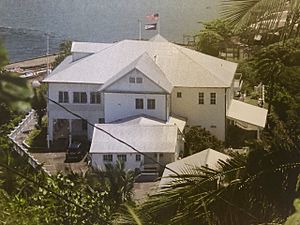
Two tall radio towers, each 450 feet high, once stood where the Historic District Pedestrian Park is now. They were near the old Radio Station, Navy Building No. 38. This building was built in 1917 during World War I. It is 60 square feet and was the first building made with fake-rock cement blocks. It was changed in the 1970s to become the Amerika Samoa Bank.
Today, the malae (or "Malae o le Talu") is a large grassy area. It is on the south side of the road and is used for ceremonies in Pago Pago. When the Navy was in charge, it was called the Parade Ground. It was used for training and performances by the Fita Fita Guard and Band. A small bandstand was at one end of the malae. The old Parade Ground is now on the U.S. National Register of Historic Places. It is part of the U.S. Naval Station Tutuila Historic District.
The American Samoa Department of Public Safety building is a two-story white building. It has an arched porch on the first floor. This building was built in 1908 by the Fita Fita Guard. It was known as the Fita Fita Barracks (Navy Building No. 31). West of the old barracks is the former Samoan Jail (Navy Building No. 72). This building now serves as offices for Interpol and other law enforcement groups. The jail was built by 1917. During World War I, the commandant held two German ship crews here. The building is a one-story concrete structure, 50 square feet in size.
West of the Samoan Jail is the old Bake Shop, Navy Building No. 45. It was built in 1919. Today, this 40-square-foot building houses Samoa Photo Express and Western Union. Further down the main street is the Maota Fono complex. This is now the home of the American Samoa Legislature. The original Fono building burned down in 1970. The Fono then moved to its new buildings in 1973.
Between Scanlan's Inn and T&K General Merchandise, there is a path leading to the Catholic Co-Cathedral of St. Joseph the Worker. This cathedral was built in 1959. A larger white church, the Congregational Christian Church, is slightly west of the malae. It is also known as "O Le Ki O Le Malo O Le Lagi" (The Key to the Kingdom of Heaven). This church was built on the site of an older church from 1904. Its cornerstone was laid in 1933. However, construction stopped during World War II. The church was finally finished and dedicated in 1949. It had a big two-year renovation in 1994.
In front of the church is the High Court of American Samoa building. It was originally the Naval Station Administration Building (Navy Building No. 21), built in 1904. When it was restored in 1998, a lot of effort went into making it look like the original. Much of the old wooden interior was also saved and repaired.
Who Lives in Fagatogo?
Fagatogo has more different kinds of people living there than any other village in American Samoa. Most residents are Samoans, from the original families. But many immigrants also live in Fagatogo. They come from places like Western Samoa, the Philippines, Tonga, Fiji, South Korea, Europe, China, and the mainland United States.
In 2010, Fagatogo had 1,737 people. This was a decrease from 2,096 people in 2000. About 85% of the people living in the village were under 50 years old.
From 1980 to 1990, the population of Fagatogo grew from 1,944 to 2,323 people. In the early 1980s, 23% of residents were born outside American Samoa. This number grew to 41% between 1985 and 1990. By 1990, 52% of residents were born outside American Samoa.
In 2000, 81.6% of Fagatogo's people were Native Hawaiian or Other Pacific Island race. 12.5% were Asian, and 3.6% were white. In 2020, Fagatogo had a higher Hispanic population (2.3%) than the rest of American Samoa.
Religious Life in Fagatogo
Fagatogo has several large churches. These include the Congregational Christian Church in American Samoa (CCCAS) and a Roman Catholic Church. Other churches, like the Methodist Church and the Congregational Christian Church in Samoa, are also present.
Fagatogo's Economy
Fagatogo is the most developed village on Tutuila Island. It is the main center for trade. Many of the village's original families still follow traditional ways of life. They rely on the land and sea for their daily needs. Others work for the Government of American Samoa. They might have jobs in the legislature, executive, or judicial branches. Homes are built on hills and mountain slopes. These areas are good for planting fruit trees and vegetables. You can find all kinds of fresh produce at the Fagatogo Market.
Fagatogo Square has private businesses and government offices. It also has places to eat and shops. This mall is right next to the Fagatogo Market. The market is considered the center of Pago Pago. It has many restaurants, shops, and bars. You can often find live music and entertainment there. Souvenirs are sold at the market when cruise ships visit. Locals also sell handmade crafts at the dock and on the main street. From the market, you can see Mount ʻAlava, the canneries in Atu'u, Rainmaker Mountain (Mount Pioa), and Pago Pago Harbor. The main bus station is right behind the market. The Luman’ai Building houses the Pago Pago Post Office and various business offices. Pago Pago's museum, movie theater, bars, and taxi services are all in Fagatogo. This is why it is known as Downtown Pago Pago.
The Sadie Thompson Inn is also in Fagatogo (Malaloa). It is named after a character from the story Rain (1921). The English author W. Somerset Maugham stayed here in December 1916. Today, it is a bed and breakfast inn. It was added to the U.S. National Register of Historic Places in 2003.
Sports and Recreation
The Fagatogo Blues Rugby Team has won the main shield for the American Samoa Rugby Union’s Annual Tournament many times. Fagatogo also takes part in the yearly Fautasi Race. This race happens during the Flag Day celebrations and the Moso'oi Festival. Women residents formed the Fagatogo Teine o le Malaeoletalu cricket team. This team has won the championship title in women's cricket for several seasons.
Places to Visit in Fagatogo
- High Court of American Samoa: A historic area listed on the U.S. National Register of Historic Places.
- Fagatogo Square: A shopping and business center.
- Fagatogo Market: A busy market and central hub.
- U.S. Naval Station Tutuila Historic District: A collection of historic naval buildings.
- Navy Building 38: A historic building listed on the U.S. National Register of Historic Places.
- Jean P. Haydon Museum: A museum listed on the U.S. National Register of Historic Places.
- Sadie Thompson Inn: A historic inn listed on the U.S. National Register of Historic Places.
- Co-Cathedral of St. Joseph the Worker: A beautiful Catholic church.
Famous People From Fagatogo
- Bob Apisa
- Lutu T. S. Fuimaono
- Mike Gabbard
- John Kneubuhl
- Tuiasosopo Mariota
- Sa'eu Scanlan
- Faoa Aitofele Sunia
- Tauese Sunia
- Napoleon Andrew Tuiteleleapaga
- Galeai Moaaliitele Tuufuli
- Maiavaaitu Oliva Hunkin: A member of the American Samoa House of Representatives.
- Dr. Julia Lyons: A professor at the University of Oregon and Chief Pediatrician at the LBJ Tropical Medical Center (LBJTMC).
- Fred Urhle: The first Samoan department director in the Navy administration.
Images for kids
See also
 In Spanish: Fagatogo para niños
In Spanish: Fagatogo para niños






